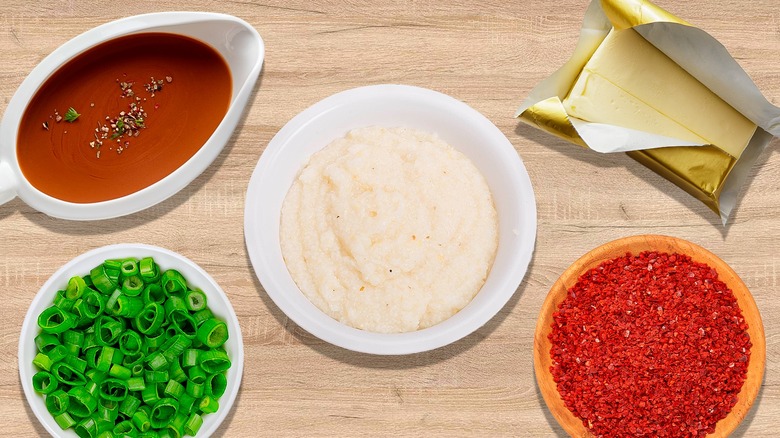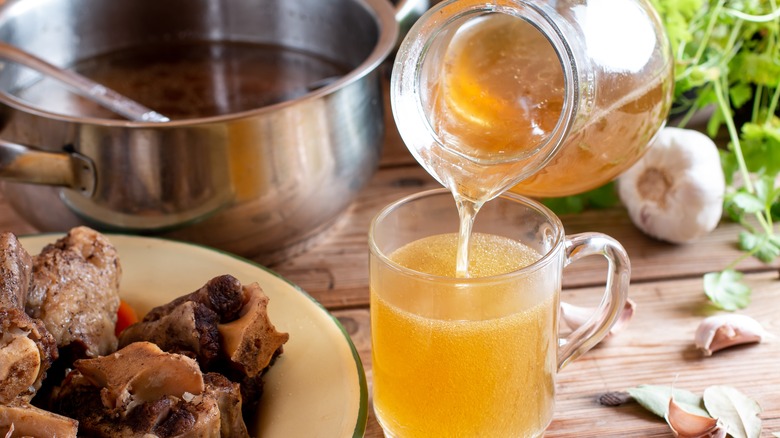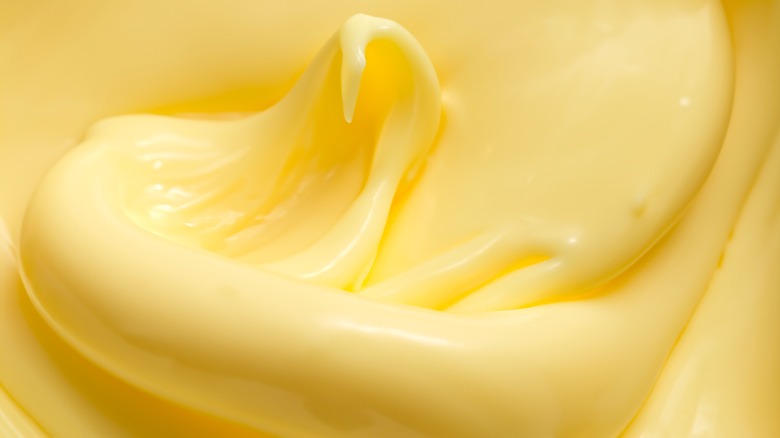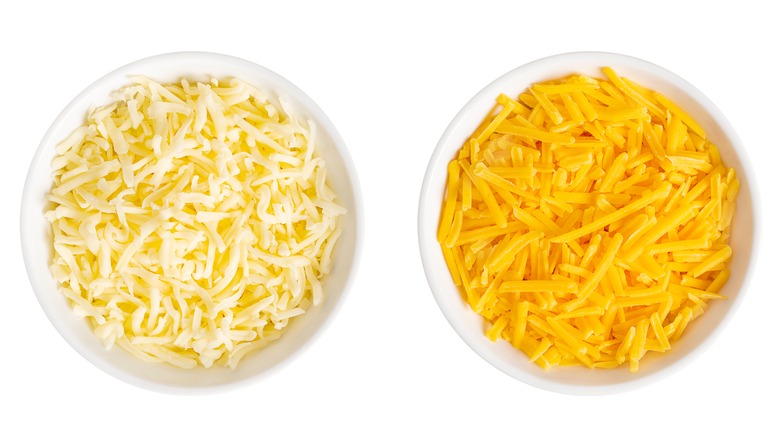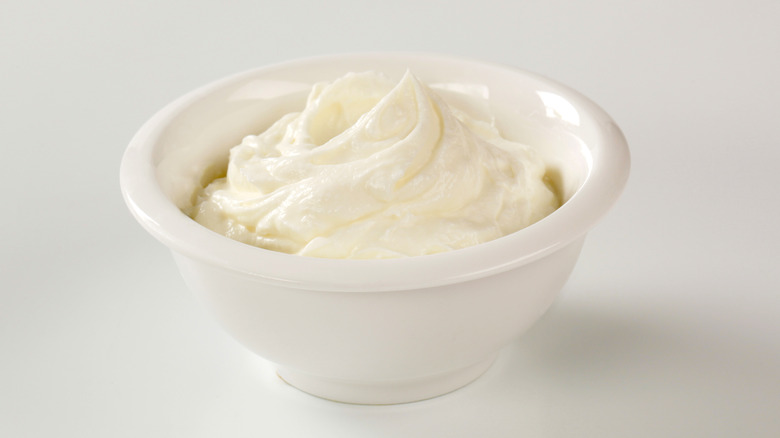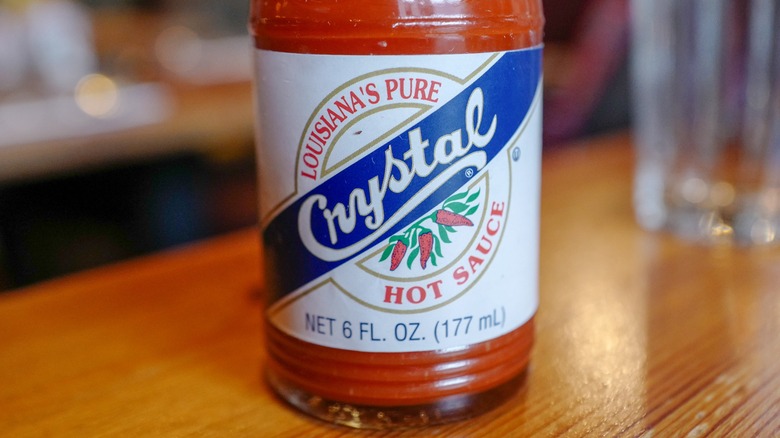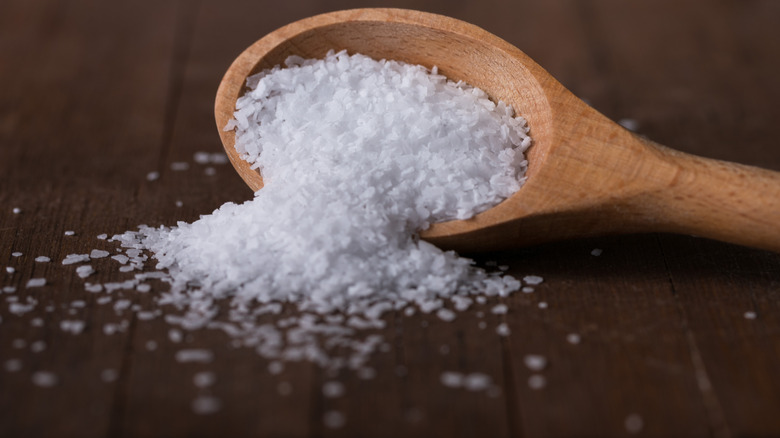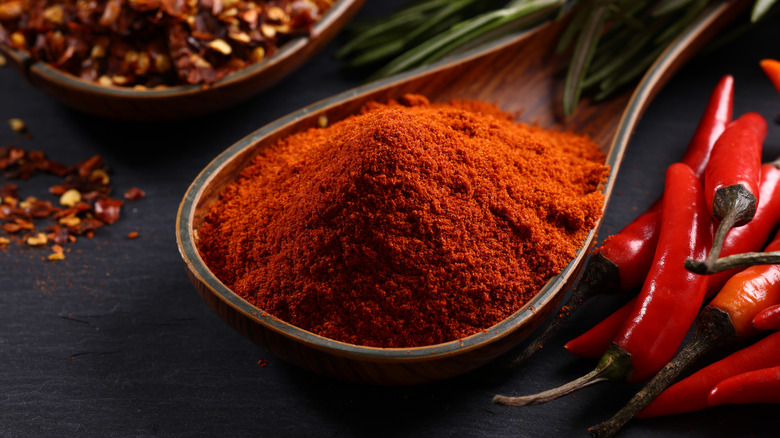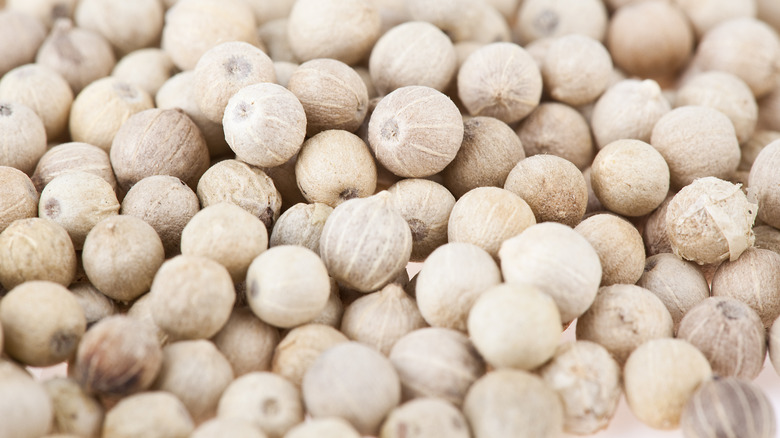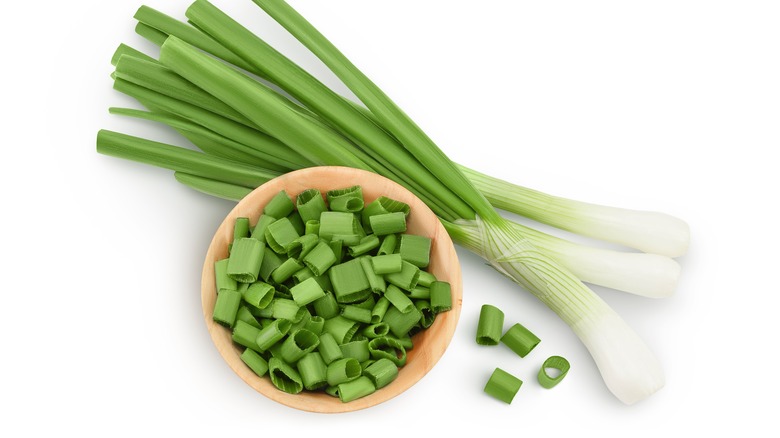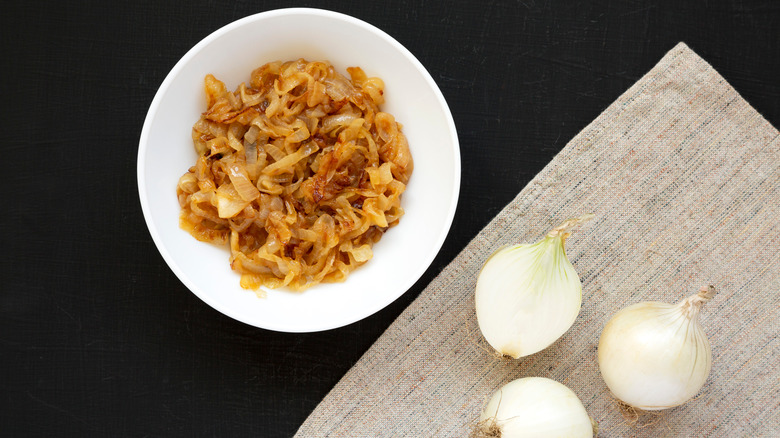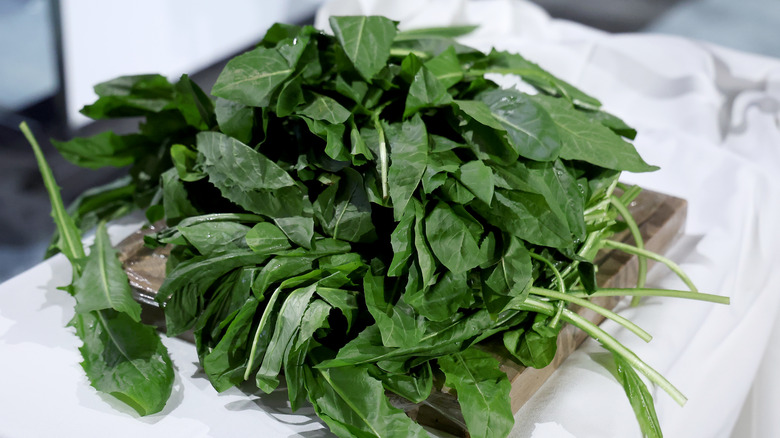14 Ingredients For Elevated Grits, According To A Chef
What makes a bowl of grits worth its salt (or grain, perhaps)? Is it the sum of its parts, or is it more than that? Grits are a popular starch made from ground corn kernels. The cornmeal is boiled to create a creamy, porridge-like consistency. Although grits originated in Native American cooking traditions, they have become deeply ingrained in Southern food culture and have spread to kitchens across the country.
All you need to make grits is water and ground kernels, but there's much more to it than that if you want to turn the otherwise flavorless cornmeal into something remarkable. As a professional cook who worked in Southern kitchens, I've spent a lot of time trying my hand at grits both in a professional setting and at home. I've seen many ingredients that work harmoniously with grits and others that don't. It's the little things in life that matter most, and this list includes the seemingly small additions you can add to make your next bowl (or two — or three) of grits that much more special.
Stock or broth
Most back-of-the-box grits recipes will tell you to use water. However, using stock instead of water can elevate the flavor profile and add depth to your grits in more ways than one. Whether it's chicken, vegetable, pork, or beef, stock contains various seasonings and aromatics that infuse the grits with rich flavors and enhance their taste. If you're using an animal-based stock, you'll also find natural gelatin and umami from the meat and the bones, which will help elevate the flavors. The gelatin helps thicken the mix and gives it more body. Just make sure you use homemade stock — not the boxed stuff, which has virtually no flavor or gelatin.
Bone broth, which has received a ton of hype in recent years, is also a great addition to your grits. Both bone broths and stocks are full of nutrients and minerals, but the former is cooked longer, so there is more time to extract the collagen from the bones. You can use both interchangeably in your recipe.
The stock you use can be tailored to the flavor you're going for in your grits. Whipping up some shrimp and grits? Buy shell-on shrimp and reserve the shells and tails to steep in the water and make shrimp stock. Now, you've got some extra shrimpy grits.
Whole milk
You'll often find grits recipes that call for milk, and it's important to know that your choice of dairy product matters. Whole milk, for example, adds richness, creaminess, and body to the grits. This is because it contains more milk fat than lower-fat alternatives, such as skim milk or water. The fat content in whole milk contributes to a velvety smoothness that coats each grain and gives creamy grits that unmistakable texture. That body isn't achievable with thinner milk since there just isn't enough fat.
The sugar content in whole milk also adds a slight sweetness to the grits. That little touch is important when adding spices like cayenne or hot sauce to mix. Nothing pairs together like sweet and spicy, especially in Southern cooking. To use this ingredient, bring equal parts whole milk and stock to a boil, then immediately reduce it to a gentle simmer. Whisk in your grits slowly, in a steady stream.
Butter
Milk is just the start of the decadent dairy additions you can add to grits. Throwing some (or a lot) of butter in your pot will give you the upper hand in creating the creamiest and richest grits possible. Unsalted butter is the best choice for your grits recipe. Using this type of butter will allow you to control the saltiness of the grits and prevent you from accidentally overseasoning them. If you can, spend a bit more on a high-quality variety, like European butter. This type has a higher fat content, which can help impart a serious creaminess and a more pronounced buttery flavor. Simply put: More fat equals richer grits.
Most people add butter after the grits finish cooking. Once you remove the grits from the heat, gradually stir in the desired amount of butter (preferably in cubes) until it melts completely. This will help make sure the dairy is evenly distributed throughout. The fat in butter will help bind the grits together, resulting in an extra silky texture. It will also help balance out any added acidity or bitterness from other ingredients or garnishes.
Cheese
What good are grits without the cheese? Cheese is one of the most powerful binding agents for your grits. It melts and melds to the corn to make the mixture ooey and gooey. But cheese also imparts a ton of flavor, and the grits will easily absorb those notes. So, choose your cheese wisely.
Traditional Southern-style cheesy grits are made with soft, rich cheeses like cheddar or gouda, which add a subtle and smooth creaminess. These cheeses allow the flavors of the corn to shine while giving the grits thickness and body. But incorporating a piquant cheese as well, such as sharp cheddar or aged Parmesan, adds boldness and depth to the grits. These cheeses bring a tangy, savory punch that cuts through the grits' richness; it's a flavor contrast you never knew you needed.
If you want to explore a more unconventional pairing, try mixing in an ultra-rich cheese like Camembert or Brie, followed by something super funky like Gorgonzola or a mature Stilton. Like most things in cooking, good grits are all about achieving a good contrast of flavors. I recommend adding your cheeses incrementally after you've finished cooking the grits so that you won't risk overcooking the cheese.
Cream cheese
If you're looking to bulk up the creaminess of your grits, consider adding a hunk of cream cheese. It's much smoother and richer than cheeses with lower moisture levels, meaning it will melt seamlessly into the grits and thicken them significantly. The slightly acidic cream cheese adds a tangy complexity that will upgrade your grits. This unique taste will help balance out the natural sweetness of the corn and milk and add a depth of flavor without overpowering it.
If you want to get creative, you can experiment with the flavors of cream cheese you add. Try a scallion or a herb-infused cream cheese for something extra aromatic. You'll want to add your cream cheese at the end once your grits are fully cooked and have reached your desired consistency. Then, pull your grits off the heat source, add the cream cheese in small hunks or dollops at a time, and whisk to fully incorporate the two together.
Hot sauce
As with almost any Southern food, grits go from good to incredible with a splash of hot sauce. Hot sauce — particularly more vinegary Southern varieties like Crystal, Louisiana, and Tabasco — contributes a unique combination of heat, acidity, and flavor that complements and cuts the creamy richness of all the dairy and fat in your grits.
You'll want to add your hot sauce incrementally and avoid overdoing it. Slowly adding this ingredient will allow you to match the flavor to your personal preference and spice tolerance. Taste as you go, adding a little bit at a time until you've got the right amount of acidity and heat you're looking for. Ideally, the hot sauce you add should add a bright, high note to your grits rather than completely take over the subtle flavors of other ingredients.
Add the hot sauce after the grits have finished simmering so the flavors are at their brightest. You can also serve the grits with additional hot sauce to taste.
Salt
This one should be a no-brainer, but sometimes, good salty seasoning is overlooked or taken for granted. The salt you add to your grits—and really, to any food you cook — absolutely matters and can significantly change how your food tastes, for better or worse.
Salt is a flavor enhancer. Its chemical composition scientifically makes food taste better by concentrating flavor compounds and making them more readily available for our tastebuds to detect them. By adding salt to food, you simply make it more flavorful. But the salt you choose is equally as important as how much of it you add.
You should use kosher salt from brands like Diamond Crystal or Morton as a general, all-purpose salt. This is because kosher salt contains no iodine or anti-clumping agents, so it won't impart any metallic or unwanted flavors to your food. Kosher salt is also the least salty type of salt because of its structure, which makes it harder to over-season your food when using kosher salt. Thus, using high-quality kosher salt to season your grits will give you the most control over the flavor and saltiness of your dish.
Paprika
Paprika is one of those underrated spices that deserves more airtime than it gets. Like cayenne, this finely ground red powder is made from the Capsicum annum chile. You'll find several varieties of this spice to choose from, including sweet paprika and smoked paprika. Overall, it's much more subtle than other chiles but does wonders for upgrading your grits. Paprika imparts a subtle smokiness, earthiness, and a touch of mild heat. The paprika's smoky and earthy undertones can complement the sweetness from the corn, while the hint of heat adds a high note to the mix. Paprika's bright red hue also helps add some nice color to grits, usually turning them yellow or orange, depending on how much is used.
Add the paprika once you've finished cooking the grits for the most vibrant color and forward flavor. You might even consider dusting the top of a serving with a shake or two for a powdery garnish.
White pepper
You might wonder why white pepper is on this list instead of the more common black pepper. White pepper is made from the ripe berries of the pepper plant, with the outer black husk removed. This results in a milder taste and a slightly different flavor profile than black pepper. Some varieties of white pepper — like those from the Guangdong Province of China and parts of Southeast Asia — are fermented, which can help amplify the umami flavor in your grits. Some liken the taste of fermented white peppercorns to miso paste, so it's easy to see this ingredient's potential for adding complex flavors.
Generally speaking, white pepper is more delicate and nuanced, which allows it to complement the creamy texture and subtle sweetness of grits without overpowering them. It is also quite lightly colored (hence the name), so it won't add black flecks to the grits. Mill some white pepper onto your grits when you finish cooking them to add a unique peppery flavor to your dish.
Scallions
Scallions (or green onions, depending on who you talk to) are among the most popular garnishes for grits. This allium, also called "spring onions," will take your grits to the next level with a mild yet distinct, fresh flavor. Raw green onions have a hint of vegetal spice, similar to that of other raw onions, garlic, or ginger.
When chopped in rounds, a fresh handful of scallions — both the green and white parts of the plant — adds some nice roughage for texture, a bright green color to contrast the paleness of the grits, and a pop of fresh, bright flavor notes that are characteristic of this herby onion. Slice your scallions as thinly as possible (using a sharp knife helps) and use them to garnish each serving of this side dish. A nice sprinkle, compared to a generous handful, will do just fine. You don't want the raw onion flavor to take over your grits.
Caramelized onions
Although it may be unconventional, I'm a big proponent of using caramelized onions as a topping for grits. The cooking process for caramelized onions is simple. Red or yellow onions are cooked low and slow until they become golden brown, translucent, and intensely flavorful, thanks to a natural sweetness developed during the caramelization process.
Because caramelized onions are both sweet and savory, they add a lot of flavor complexity to grits and almost melt into the mixture. The soft, jammy, and melt-in-your-mouth texture of caramelized onions helps with the creaminess of the grits (as if they needed help). Southerners might disagree with me on this, but I promise caramelized onions are the perfect rich and savory addition to this classic side. Caramelize the onions on the stove in butter or olive oil while your grits cook, and spoon them over the top of the grits as a finishing garnish. Or, save stovetop space for your grits by cooking the caramelized onions in the oven.
Poached eggs
Adding poached eggs to grits can transform this side from a regular breakfast item into a fancy-ish, brunch-worthy, and satisfying meal. Poached eggs, with their delicate whites and creamy yolks, provide a velvety texture and rich flavor that complements the creamy consistency of the grits. It's almost like those yolks are begging to be swirled into your bowl. When the soft yolk of the poached egg mixes with the creamy grits, it creates a sauce-like consistency in each bite. You'll also appreciate the extra boost of protein that comes with these nutrient-dense powerhouses.
Make sure you cook your eggs right before serving. The eggs are difficult to handle and hold for very long after they've been cooked, so you'll want to do it at the last minute. This will also help your yolks stay runny, creamy, and hot. Don't be shy; spoon a couple right over the top of that bowl and hit it with some salt, pepper, and hot sauce.
Gravy
Gravy seems like a natural pairing for grits. And, after all, has anyone ever said no to a spoonful?
If you're looking to level up that meaty flavor from your stock — and especially if you're planning on adding meat to the top of your grits — keep a crock of gravy handy. As always, I love anything that can make grits creamier and richer, and gravy does just the trick. Like any sauce made from stock, your gravy will only be as good as its base. If you're already making stock (or have some on hand) for your grits, save a few cups to make into a quick gravy. When serving grits with gravy, it's best to pour the warm sauce over the cooked grits just before serving. You want to ensure those grits stay creamy, moist, and flavorful. I also recommend placing the extra on the table, just in case you want an extra serving.
Bitter vegetables
Bitter vegetables are a great, nutritious boost for this decadent side dish. While collard greens are the most classic pairing with grits, any bitter veggie can be delicious — including kale, spinach, mustard greens, dandelion greens, and even radicchio. Adding bitter vegetables to grits provides a contrast of flavors and textures that make grits next-level interesting. The vegetal bitterness of the greens balances some of the sweetness already present in grits. It also enhances the texture and adds a satisfying vegetal bite that will distract your tastebuds from the depth of flavor in the thick, rich grits.
Adding fat to your grits and greens will also help your body absorb the bioavailable nutrients in the vegetable, including vitamins A, D, and E. Saute, braise, or char your vegetables to help soften them, draw out the flavors, and mellow some of the bitterness. Then, chop your bitter greens into bite-size pieces and serve alongside the grits or on top as a garnish.
